As the son of a two-times world champion, Damon Hill had the unusual experience of driving historic Formula 1 cars before setting foot in contemporary cars.
Graham Hill died in an aircraft accident shortly after retiring from F1 in 1975. His son, 15 years old at the time, later drove his father’s old cars and attracted inevitable attention as he worked his way through Formula Ford, F3 and F3000.Hill took an unusual route to single seaters after the accident. His family found itself in constrained circumstances after the accident, and Damon worked as building labourer and motorcycle courier, using income from the former to fund club events, mainly at Brands Hatch, racing the machine he used for dispatch activities. Mother Bette, however, decided cars were safer than bikes, so packed him to the Winfield Racing School in France in 1983.
In the first two junior rungs he proved an occasional winner, but F3000 was a tougher nut to crack, with Damon – by then in his thirties with a wife, first child and mortgage – scoring the odd pole position and podium. Crucially, he had done enough to impress both Peter Collins – then Benetton boss and the man Vitantonio Liuzzi and Johnny Herbert credit their F1 careers to – and, crucially, Sir Frank Williams.
Thus, Damon’s first F1 experience came at Paul Ricard courtesy of a turbocharged Benetton B187-Ford, its power trimmed to naturally aspirated levels for comparison testing after the turbo era ended. He recalls mind-blowing power and acceleration despite it having ‘only’ 650bhp rather than the famed 1,000bhp available in qualifying trim.
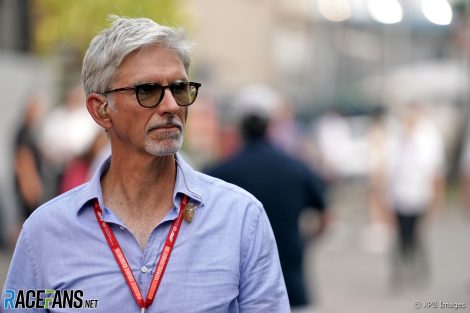
In 1991 Williams called, offering test duties with the Renault-powered FW13 initially rigged up with a manual gearbox. It was later fitted with a semi-automatic transmission as development mule for the FW14, the first Adrian Newey-designed Williams.
“I did a bit running on that and then some development for the active suspension car.” This was the FW14B, its all-conquering successor.
In the meantime an opportunity to make his F1 race debut arose with Brabham. The former champions staggered into 1992 with a reworked version of their previous chassis, using customer Judd engines having lost Yamaha’s backing.
Advert | Become a RaceFans supporter and
After Akihiko Nakaya was denied a superlicence, Giovanna Amati was named as Eric van de Poele’s team mate. She failed to qualify for the first three races (van de Poele only made the cut once), and her promised backing never materialised, which handed Hill his chance.
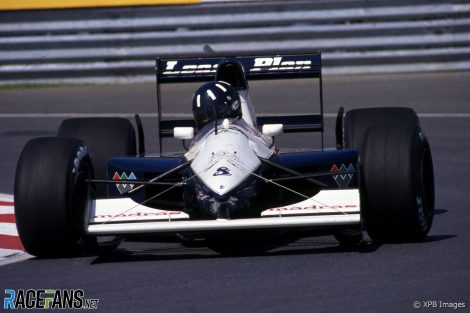
The Brabham BT60B was “a completely rubbish car and at the back of the grid” but Hill “wanted to know what it’s like to be in a grand prix.”
“I needed to get the experience because everyone could see what times I was doing in the active Williams, but it wasn’t registering because I wasn’t actually competing,” he explains. “So, they gave me a go.
“We drove at Monaco, but basically I couldn’t shift gears because it was so tight in the cockpit I couldn’t get the gear lever across to get all the gears so only had four gears at Monaco. I went around hairpin in about third I think. I qualified the car for the 1992 British Grand Prix.”
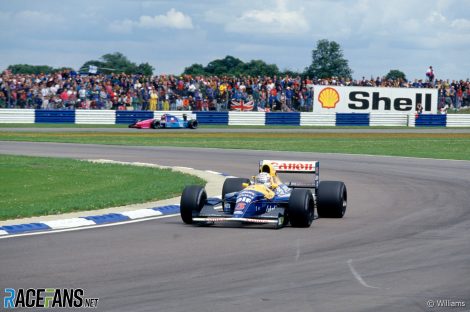
Hill credits Tim Densham – the team’s chief designer who doubled as his race engineer – “so quiet you’d never know he’s there but brilliant at what he did” – with getting the car in the sweet spot at Silverstone and the Hungaroring. At the latter, Hill put his Brabham on the grid and finished 11th in what proved the once-great team’s final race.
“Then they ran out money and it folded. It was probably quite dangerous, because I think they were running old bits. It was a bit wild, really, but we didn’t know any different.”
Then 1992 champion Mansell got the hump with Williams and moved to IndyCar. In December Hill was announced as team mate to Alain Prost in an all-new line up driving the FW15C.
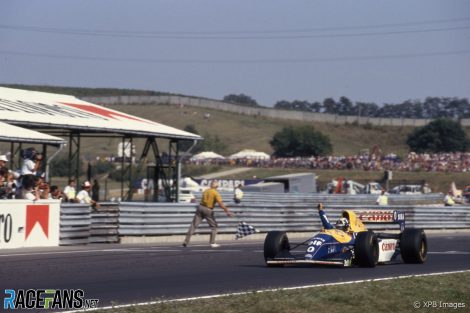
“It had unfeasibly low ride heights controlled by a hydraulic platform that could gauge precisely how far the floor was from the ground, within a millimetre or so.
“You could generate downforce, it could change attitudes fore and aft, side to side. You could play with it in all sorts of directions.
“We developed traction control in that car. By the end we had power brakes with a pressure transducer on the pedal instead of the pedal being hydraulic. It converted pressure into a signal that then braked the car for you, so you had anti-lock brakes. It was just mind-blowing to drive.”
Advert | Become a RaceFans supporter and
But the astonishingly rapid advances in driver aids prompted the FIA to intervene, banning a swathe of technologies which gave Williams a margin of superiority which was measured in whole seconds. After the season, Hill gave the car a last blast before simpler cars arrived in 1994.
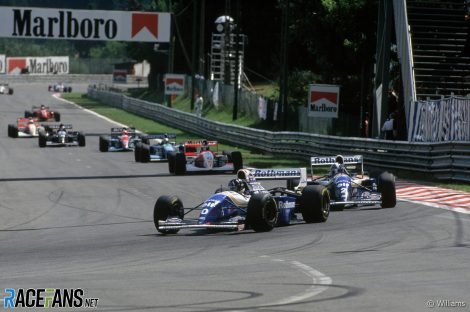
For 1994 he had a new team mate in the form of Ayrton Senna, a new challenge in the shape of Michael Schumacher and Benetton, and the mechanically suspended FW16. It proved troublesome at first, and following the shock of Senna’s death at Imola and further hasty revisions to the regulations, Williams pressed a ‘B’ version into service with heavily revised aerodynamics.
Although Hill placed second in the opener in Brazil, he was a lap down on Schumacher, while Senna uncharacteristically spun into retirement.
“That [car] was such a rough ride and Ayrton spun off, which I think gives an indication of how difficult it was. He was totally exhausted and couldn’t hang on. It was like a bucking bronco, quite difficult to drive so we had to work on it.

Still, Hill scored six wins – including probably his greatest victory, in a two-parter at Suzuka – and went into the final round in Adelaide a point behind Schumacher at the top of the points table. Infamously, the Benetton driver had him off after clouting the wall, clinching the title in controversial fashion.
Did Hill discuss Schumacher’s swerve with him – and did he defend the move at all? “I don’t think he felt he had to, really,” says Hill. “I think he just left it there. That’s what he did, and that’s what happened, and that was the result.”
For 1995 the FIA demanded further aerodynamic a reduction in engine capacity to three litres. The 1995 FW17 was therefore a clean-sheet design which “moved away from the kind of dolphin nose shape to a higher nose shape, much more sort of pencil looking.
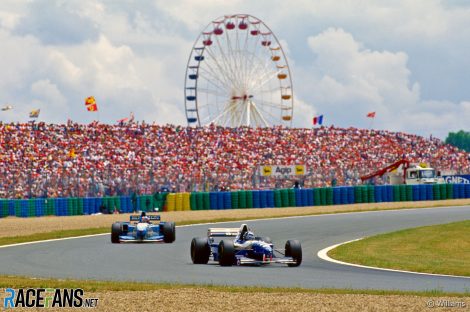
It was a good car, says Hill, which won four races and bag five further podiums, but it proved insufficient to stop Schumacher, whose team had joined Williams in using the same Renault V10 power units. Each successive engine proved an effective evolution of what went before.
“The basic block was pretty much the same, but they just kept on coming back with 200 revs more, and the power just kept on going up all the time. It was quite fun to develop the Renault engine, and I have to say that during my time at Williams the Renault engine development was very impressive, and it was the class of the field.”
He also enjoyed working with Newey. “I really respect Adrian, he is a really good driver-engineer who listens to the driver. You could tell he wanted to hear what you have to say, which is really encouraging. He was very good at making me a part of a team. He is very competitive and also has a sense of humour, but he doesn’t like to lose.”
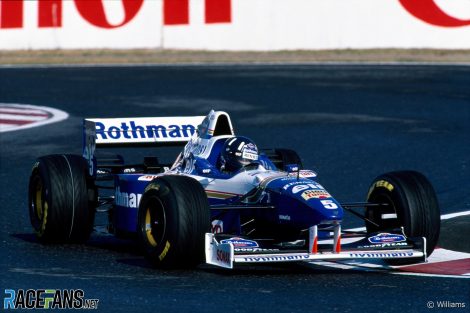
The car was “a move-on, an evolution from the previous year and it was the best car I ever drove in F1.” Even the ultra-high-tech FW14B and 15C?
“Better than all of them, it was just light, nimble, responsive, powerful, really well-balanced and it fitted me like a cast because I asked Adrian to ensure I fitted in the car.” Then, with a grin he adds, “I would say it’s the only car that had size 11 feet.”
Eight wins and the world championship were the result, with Villeneuve runner-up, 19 points adrift despite a structure that paid 10 points for a win and rewarded to sixth place. Yet before the championship was settled Frank Williams declined to extend Hill’s contract, saying “I must do what’s best for the team”. That left Hill with few options. He was eyeing a seat at McLaren, where Newey had headed, for 1998, but that team was full for 1997.
Thus closed the Williams chapter. Hill didn’t even take one of the cars he had driven to world championship glory. “I wasn’t smart enough to keep them,” he admits. “I didn’t really like negotiating with Frank, so I just thought I better not push my luck.”
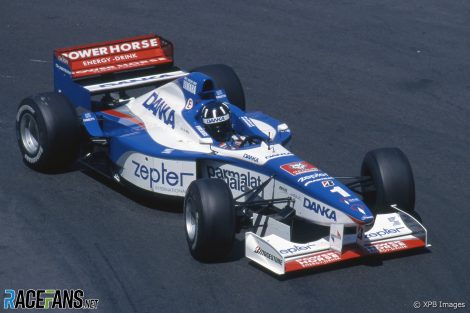
Although John Barnard had by then joined the team, he was more focussed on the 1998 car and had limited input into Hill’s 1997 mount. “The engine was really a Judd and they just developed the engine a bit,” he says.
The arrival of Japanese tyre manufacturer Bridgestone as a rival to Goodyear – supplying Arrows among others – sparked a new tyre war which saw lap times tumble. “The Bridgestones were really the key to it because you could really use those tyres and they didn’t degrade. They were very durable and forgiving.”
So durable that on a scorching day at the Hungaroring Hill led until a lap-and-a-bit from the end, when a hydraulic failure set in. Villeneuve shot past Hill on the final lap, denying Arrows what would have been its only victory in 25 years of trying.
But the rising cornering speeds spooked the FIA. President Max Mosley demanded slick racing tyres be replaced with narrower grooved versions for 1998. Hill remains scathing about that decision:

Hill, 37 at the start of the season, already had one eye on retirement. Nonetheless he threw his lot in with Eddie Jordan’s team alongside Ralf Schumacher, younger brother of his former nemesis.
“I went to Eddie because basically [McLaren] was off the table,” he explains. “So I thought, ‘Okay, retirement package two years at Jordan, if I like, I stay.
“We had to develop the engine, the Mugen-Honda. It was good but it had to be better, and it got better. I was learning about Eddie Jordan’s management style, which is something a little bit different. I basically played my part in helping them to win the race at Spa.”
The Jordan 198 had failed to score point in the first half of the season, and technical director Gary Anderson left. Hill’s recollection is “the car wasn’t too bad, it was a bit boxy, wasn’t a beauty but it was okay,” adding, “Basically, I tried to explain that ‘you’re never going to win anything if you keep copying everyone else.’
“They got Mike Gascoyne in, and then I made progress,” he says. He put the car third on the grid behind the McLarens at Spa. On race day the rain tipped down, the silver cars and Schumacher went out in collisions, and Hill led the team to its first win and one-two.
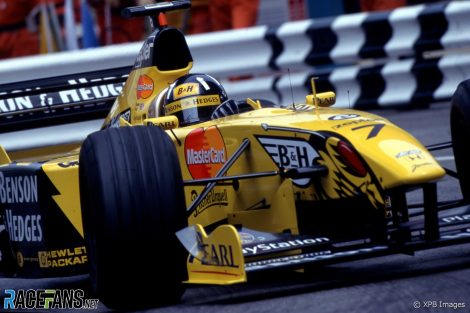
“When you you’ve been at the front it’s very difficult to be making up numbers and to get the kind of spark you get from being at the front. I was 39.
“I wanted the British Grand Prix to be my last race, and Eddie wanted me to leave before the race. Then he said he wanted me to stay to the end, I think there was another deal going, that he wanted to get another driver because there was some money from somewhere. That’s usually the thing with Eddie.
“He didn’t like the fact that I was being paid by [sponsor] Benson and Hedges, and basically I wanted to get some comfort that I was going to get paid properly. I think he took exception to that.”
Hill saw out the 1999 season but while Frentzen made a surprise bid for the title, the world champion took just four points finishes: Fourth place at Imola, fifth on home soil and a pair of sixth places.
Today he’s on the roster of Sky’s F1 experts, bringing the benefit of his world championship win and 22 grand prix victories to provide incisive analysis. It’s a long way from thrashing a ‘clubbie’ production bike around Brands Hatch – where he won his only other championship title.
My F1 Cars
- Herbert on his painful debut, Schumacher’s title-winning Benettons and more
- ‘Aston Martin still use my steering wheel design’ – Liuzzi on his F1 career in cars
- Villeneuve on Williams’ last title-winner, BMW grief and Alonso’s ‘un-driveable’ Renault
- Coulthard on the CVT Williams, McLaren’s little-known tricks and Newey’s first Red Bulls
- My F1 Cars: Webber’s route from ‘pain in the ass’ Minardi to all-conquering Red Bull





BasCB (@bascb)
18th October 2021, 14:36
Keep these great reads coming @dieterrencken! They are such a joy to read.
GeeMac (@geemac)
18th October 2021, 14:43
Absolutely love this series, and of course any time the Arrows A18 pops up is fine by me.
Derek Edwards
18th October 2021, 15:11
Although he had retired from driving Graham Hill was still actively involved in F1 at the time of his death, through his team. In a different universe maybe Damon would have made his GP debut in a Hill GH18.
Markus (@aesto)
18th October 2021, 15:32
In his book he says that when he was young, he didn’t even like car racing (he preferred bikes) and he only did it for the money, which he wouldn’t have needed if his dad hadn’t died. So odds are, he never would have made his F1 debut at all.
Joe Pineapples
18th October 2021, 15:41
I remember him showing the media his new Arrows, calling it his “little Spitfire”.
Balue (@balue)
18th October 2021, 16:02
Nice read. Fun bit about Villeneuve wanting to be different, but maybe too much gloss over Hill’s departure from Williams, which even Hill himself since has explained was partly his fault (having his manager talk too tough).
Robbie (@robbie)
18th October 2021, 21:30
It seems from what I understand what was going on at Williams for JV was that initially he was being told how to set up the car based on their computer models and he had to somewhat fight to have his say into what he thought would be best set up wise for himself.
Ruben
18th October 2021, 16:04
Did anybody already do a Damon Hill tribute helmet in recent years? If not: it’s about time.
Markp
18th October 2021, 18:39
Damon’s was a Graham Hill tribute. His dad originally used it, it was from a rowing club he was part of that I cannot think of the name as typing. I do know it but refuse to Google it.
GnosticBrian
19th October 2021, 13:47
London rowing club.
Paul
20th October 2021, 23:07
Putney
Darryn Smith (@darryn)
18th October 2021, 20:12
Damon’s was the tribute.
Ruben
19th October 2021, 8:34
Lol :)
GeeMac (@geemac)
19th October 2021, 5:07
Josh Hill used to race in the family helmet design, but with a lighter blue.
https://i.pinimg.com/originals/88/86/89/888689bc1127ce8ead4bb8b6516c4433.jpg
aj
18th October 2021, 16:53
great article thank you!
Mark Swonson
18th October 2021, 22:59
It’s a shame he comes across as very very money motivated. I mean, we all are, but he couldn’t seem to care less about driving or winning, just making bank.
ludwig_m
20th October 2021, 7:31
The family fell on hard times after his father’s death, by the time he made his debut in F1 he was already a dad of 2 kids (4 by the time he retired) and his oldest son has Down’s syndrome, so I don’t think you can blame him for wanting financial stability for his family.
Unicron (@unicron2002)
19th October 2021, 6:56
Some beautiful cars featured here. The FW16, the FW18, and the Arrows has aged well. The Jordan 191 is my favourite F1 car of all time, but the Jordan 199 is the runner up.
ludwig_m
20th October 2021, 7:38
Great series of articles! As a Belgian, I’d really like to read a “My F1 cars” with Jacky Ickx or Thierry Boutsen :)